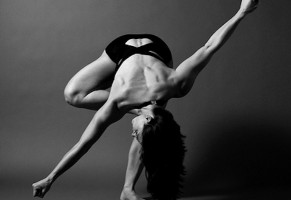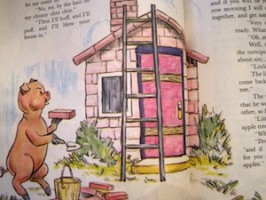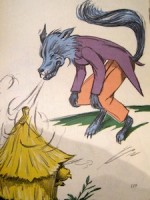
Have you ever taught anatomy to young dance students?
You might be thinking, “Why teach anatomy?” “What will they learn and how will I teach it?”
Let’s answer these questions one at a time.
Why Teach Anatomy?

Since dance is the art of motion, in order to become a proficient dancer one must understand how the body moves from the inside; how the muscles and bones work to leap, turn, kick, stretch and fold. A pretty sophisticated idea for a young dancer. Since learning is a layered experience, introducing the concepts of anatomy now will allow them to build upon this foundation in the future. As a dancer learns how to plié before he can jump, so to must he understand that the knee and ankle joints allow him to bend his legs.
The more a child understands how her body functions, the more she can develop a sense of her whole body. This ties directly to performance. We have all seen dancers who perform steps but have no connection to what they are doing. Sometimes people say these performers have no stage presence. I say they have no body presence. They have no connection to their bodies.
How To Teach Anatomy
This is the fun part. Taking basic facts about bones and muscles, you can turn your dance studio/space into a dance exploratorium!
Simple Facts:
- There are 206 bones in the human body
- Muscles, by contracting and relaxing, are what allows bones to move
- The lungs supply the body with oxygen, and gets rid of carbon dioxide
Activity 1 – 206 Bones
What does 206 look like? A lot of public schools celebrate the 100th day of school. Sometimes kids are asked to bring in 100 paperclips, rubber bands, popsicle sticks, etc. so they can see what 100 looks like. Well, what does 206 look like? Have your students bring in 206 of something or have each child bring in a certain amount of cotton balls so the total will equal 206. The point is for the children to visualize how many bones they have in their body.
See if you can have the students do 206 of a certain movement, like a skip. Have the first student skip 20 times and tag the next student and so on until the class has skipped 206 times. Having them do 206 skips helps them connect to what 206 feels like.
Activity 2- Make a Muscle
 Sitting on the floor in a circle, ask your students to show you their strong arm muscles. (They should all look like Popeye flexing their arms and squeezing their fists.) Have them tap their bicep muscles. Let them know the job of the bicep muscle is to move their arm bones. Have them shake out their arms and flex them again.
Sitting on the floor in a circle, ask your students to show you their strong arm muscles. (They should all look like Popeye flexing their arms and squeezing their fists.) Have them tap their bicep muscles. Let them know the job of the bicep muscle is to move their arm bones. Have them shake out their arms and flex them again.
Now have them flex and extend their knees. Ask them to tap their quadriceps muscles. This is the muscle moving their leg bones. Repeat this several times. Now see if they can flex both their biceps and quadriceps muscles together.
Muscles move bones. Ask the students if they can move other bones with their muscles.
Lastly, have them squeeze every muscle in their bodies! l Let them know the more they use their muscles the stronger their muscles will get and the faster and longer they will be able to move their bones!
Activity 3- I’ll Huff and I’ll Puff and I’ll Blow Your House Down
Sometimes it is hard to feel what your body is doing but you can see it. Hand out tissues or scarves to your students. Have them hold the tissue/scarf a few inches from their mouths and breathe in and then blow out. Notice what happens to the tissue. Why? You are taking in wonderful oxygen that enables you to breathe and you are sending out carbon dioxide that your body doesn’t need (but plants do!) Do it gently. Now blow hard.
 Now dance the story of the 3 little pigs. The three pigs dance together and build 3 houses. The first one is made of hay, very light and quick to build. They scoop the hay, toss, spin and skip, it is so easy to build.
Now dance the story of the 3 little pigs. The three pigs dance together and build 3 houses. The first one is made of hay, very light and quick to build. They scoop the hay, toss, spin and skip, it is so easy to build.
The second one is made of sticks, its a little heavier and takes a little longer to build. They pass the sticks to each other, climb, connect, reach and fall and reach again.
The third house is made of bricks. It takes lots of strength to build. They take lots of deep breathes as they lift, push, pull, twist, reach, balance and climb.
 Now the wolf comes. He takes one big breath inhaling in the oxygen and breathing out all the carbon dioxide and the house tumbles down. He goes to the next house and has to take two deep breathes and then the house falls down one stick at a time. Finally, he comes to the house of bricks. He takes a big breath and blows on the house. Again, and again he tries but nothing happens. His lungs are working really hard but the brick house is too strong.
Now the wolf comes. He takes one big breath inhaling in the oxygen and breathing out all the carbon dioxide and the house tumbles down. He goes to the next house and has to take two deep breathes and then the house falls down one stick at a time. Finally, he comes to the house of bricks. He takes a big breath and blows on the house. Again, and again he tries but nothing happens. His lungs are working really hard but the brick house is too strong.
He stomps away and the pigs celebrate with a dance!
What Do Students Take Away?
This is a great question to ask them.
I love to ask my students questions because this is how I learn about them, about myself and how to tailor my classes to reach them as effectively as possible. My guess, however, is that they will learn that there is more to their bodies then what they see in the mirror. And that is an awesome thing!
Can you think of more ways to explore anatomy concepts with children?
Stacey Pepper Schwartz is the Founder and Director of Leaping Legs Creative Movement Programs. The focus of Leaping Legs is to help people regardless of age, experience or ability, become educated about their movement potential, develop kinesthetic awareness, and become more physically fit and healthy together as a family, and community. Leaping Legs promotes its goal through its original Up Down & All Around DVD, teacher training, and school and community workshops. The Up Down & All Around DVD received Dr. Toy’s 100 Best Children’s Products 2009 Award and 10 Best Active Products 2009 Award. The DVD has also been featured in many magazines including Dance Teacher and Dance Retailer News. In its August 2009 issue, Dance Teacher called the DVD “an essential tool for teaching the fundamentals of movement with daily adult-child interactions.” Come visit www.leapinglegs.com to learn more about Stacey and her programs.


